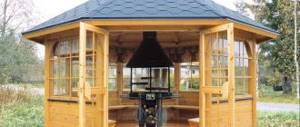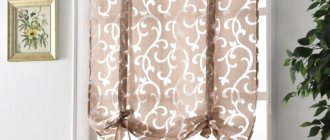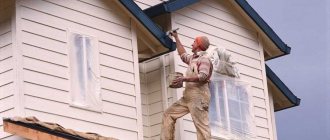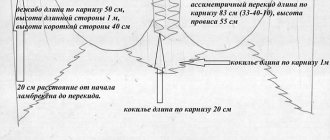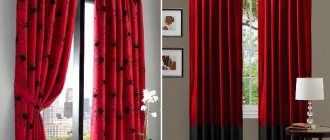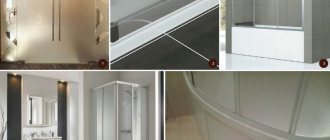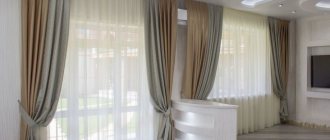At what distance from the wall to mount
The first question that arises when you start installing a cornice above a window is at what distance from the corner it should be attached. Close? Stepping back 10 cm? 20 cm?
The curtain rod should be placed so that it hangs freely without touching the window sill or heating radiators.
In fact, the distance can be from 8 to 15-20 cm. It is determined depending on the location of the heating radiators and/or window sill. The cornice must be placed so that the tulle and curtains hang freely, without touching either one or the other. Firstly, this way the drapery lies perfectly, secondly, it is better for the fabrics, and thirdly, there is better air circulation, which is important during the heating season.
Installation of a ceiling cornice to a concrete floor
The procedure for attaching a ceiling cornice is not too complicated, but if the length of the product is more than two meters, an assistant will be required. In addition to the fasteners, you only need a drill and a screwdriver with a suitable slot.
This is what an installed ceiling cornice with curtains should look like
Preparation
Before attaching the ceiling cornice, it is necessary to carry out some preparatory work. The first thing we do is adjust the length. If everything suits you, great. If you need to cut off excess, you will need a hacksaw. It is advisable to use a cloth for plastic, but it is also suitable for metal. If the cornice is assembled, remove the plugs and turns (if any), cut off the excess, then return everything to its place - the turn, the plug.
If the holes for the fasteners are not drilled at the factory, you will have to make them yourself. Let's start with the markings. Mark so that the distance between adjacent screws is no more than 50-60 cm. If there are joints, then retreat 5-10 cm from the joint on both sides. For better load distribution, it is better to stagger the mounting holes.
After the marks are set, we drill mounting holes in the plastic. Use a drill that is equal in diameter to the size of the fastener. More is undesirable, but less is also not good - when twisted, the plastic may crack.
Even for a single-row cornice, it is better to place the holes in a checkerboard pattern
After all the holes are ready, if the cornice is prefabricated, assemble all the parts. You don't have to install the decorative trim (if any). For now she will only get in the way.
How to attach
In most apartments and many private houses the ceiling is a concrete slab. Accordingly, we take a drill for concrete. The diameter of the drill should be taken according to the size of the dowel. Then we proceed according to plan:
- We apply the assembled cornice to the ceiling and level it.
- Use a simple pencil or marker to mark the attachment points.
- We drill holes, trying to hit exactly the marks. The depth is equal to the length of the plastic insert. To make control easier, you can stick a strip of electrical tape on the drill.
Already fixed, but without curtains
That's all, actually. You know how to attach a ceiling cornice to a concrete floor. If the floor is wooden, everything is even simpler: there is no need to pre-install dowels. After all, wood screws are usually used. In this case, the cornice is leveled and screws are immediately placed in the mounting holes. It’s more convenient to follow the same order: along the edges and in the center, and then - as it turns out.
Types of curtain tapes are determined by their purpose
Each type is designed to gather the fabric in a certain way.
The threads for tightening the tape must be pulled out from under the seam.
To buy braid of the required size, you should determine the density of curtain gathering. Each density corresponds to a coefficient that determines the required dimensions of the ribbon for the curtain being designed. For example, a ratio of ½ means: to get 1 m of finished curtain, you will need two meters of curtain fabric; 1/3 – you need 3 meters and so on.
You need to add 10 centimeters to the resulting length to bend the edges.
The selection of curtain tape according to the coefficient is based on the assembly of what shapes are planned to be laid on the drapery:
- those collected simply will not require a large consumption of material, the coefficient for it is 1.5;
- gathers like ruffles, puffs or waffles need double factor braid;
- folds like “rays” and “bows” - coefficient 2.5 times;
- For cylinder and triple folds, a factor of 3 should be provided.
The finished curtain must be ironed and the tape tightened to the planned width.
In most cases, curtain tape is made from polyester fabric. The advantages of the material are obvious: tight fit to the curtain, strong hold of the canvas over the entire width, eliminating sagging and deformation of the curtains.
What can curtain tapes consist of:
- from rings for eyelets;
- from pockets for hooks;
- from seals for the rigidity of the lambrequin;
- of two, three or four cords.
They produce a version of the braid that is glued to the curtain fabric using Velcro; it is not equipped with cords. All tapes are attached differently and have different devices for these purposes. They produce “universal” tapes with a multi-level arrangement of loops and pockets. They can be used on rail baguettes, as well as on rod ones. Curtain tapes made of translucent materials are intended for tulle curtains or those made of organza.
If the ceiling is plasterboard
If it was decided to install a ceiling cornice at the renovation stage, most likely there is a special niche in which it is installed. In this case, it is attached to the ceiling, and how to attach the ceiling cornice to concrete and wooden floors is described above. It will be a little more difficult, since freedom of action is limited, but not critical.
Attaching the cornice in a niche is a little more inconvenient
There may be a second option - without a niche. A wooden beam is fixed at the place where the cornice is installed. It is located between the drywall and the main floor. In this case, the ceiling cornice is attached to the beam through plasterboard. You need to use wood screws of sufficient length so that the body of the beam contains at least 2/3 of the length (preferably more).
Installation on a suspended ceiling
In the case of a suspended ceiling, the ceiling cornice can only be secured to a pre-installed embedded beam. It is secured before the fabric is stretched. When fastening, use wood screws and attach them directly to the beam through the ceiling sheet.
How to attach a ceiling cornice to a suspended ceiling
The second option is a niche for installing a cornice, but this is also made during the installation of the ceiling and not later. In this case, there is also a wooden beam, but a guide for the stretch ceiling is attached to it.
Attaching a ceiling cornice in a stretch ceiling niche
There are no options for installation on a ready-made stretch ceiling. There is, however, a compromise - mounting to the wall with brackets right under the ceiling. There is a gap to the ceiling, but it is small and not too noticeable.
Attaching the ceiling cornice to the wall
For cases with suspended or plasterboard ceilings, there is another installation option - on special brackets that are attached to the wall. In this case, the distance from the corner is determined by the parameters of the bracket. They have longitudinal slits that allow you to adjust the length at your discretion. There are several holes at a distance of 5-6 cm from each other. Wall mounting brackets usually come with mounting plates that are attached to the plastic case with four small self-tapping screws. The installation step of the fasteners for wall mounting is the same - 50-60 cm; two stops are placed at the joints, 10-15 cm away from the joint.
Types of brackets for wall mounting of ceiling curtain rods
How to attach a ceiling cornice to a wall? The installation procedure is the same as in the case of installation on a concrete ceiling: marking the mounting holes, installing dowels, then attaching the cornice itself to the wall with brackets. But with different brackets the procedure is different.
This is what comes together
Option with long cuts in the bracket body:
- The plates are fixed, the brackets are inserted into the grooves.
- We apply the cornice to the installation site, mark the holes on the wall (circle it). We outline all the holes, how many there are in the cornice.
- We make holes in the wall and insert dowels.
- We remove the brackets and fix them on the wall.
- We put plates attached to the cornice onto the brackets.
- We set it exactly, at the same distance from the wall.
- Tighten the fixing bolts.
Mounting on brackets
This option is good because, if desired, you can move the cornice closer or further within the length of the cut. You can also level out imperfect wall geometry. When using the option with several holes, it is easier to first attach the brackets to the cornice, then lift the entire structure and make markings. After installing the plastic part of the dowels, attach the cornice assembly to the wall again. As you can see, it is very difficult to do without an assistant: you need someone to hold the cornice.
How to hang curtains on a ceiling cornice
The ceiling cornice has hooks or runners for hanging curtains. Each type of profile has its own, but they come in different heights.
It is necessary to select hooks/runners according to the type of profile
Now about the difference between hooks and runners. The runners have small wheels. They are more expensive, but the curtains move much easier. To save money, you can take hooks for tulle (we move it very rarely) and runners for drapes (curtains).
Types of hooks for ceiling cornices
To hang curtains on a ceiling cornice, a special ribbon is sewn to the top of the curtain. It helps to form folds of the required size. This ribbon has a strip that can be used as loops. This is where the hooks are attached.
Curtain tape and hooks on it
There is another option - to make the loops by hand, but then the folds will have to be laid and sewn up by hand. This option will have to be used if you need to lay not standard folds, but with some special pattern.
There are two ways to hang curtains on a ceiling cornice:
- Secure the hooks to the tape, and then tuck them one by one into the desired groove on the profile. Then install the stopper, then the plug.
- The second method is to first insert the required number of hooks/runners into the groove, install a stopper and a plug. Then put loops on the hooks.
Installing the locking screw. Then you need to put a plug
The first option is physically simpler, but the second option is more often done. When you remove the hooks for washing, they may get lost, or you may make a mistake in the order in which they are installed. In general, it is not so important how exactly you hang the curtains on the ceiling cornice. The choice is yours. And finally, a small life hack on how to make it easier to put loops on hooks. This is a tedious and difficult task that irritates many.
How to hang it correctly?
It is necessary to hang curtains taking into account different types of structures. There are several types of curtain rods on which curtains are attached using hooks:
- forged;
- ceiling;
- aluminum;
- bay window;
- string;
- old and new type rack.
There are many options for fixing curtains on the cornice. Among them, curtain hooks are the most common option. They are attached to the rings and also act as independent fasteners.
The most common use of this fastening element is together with profile cornices; they are mounted on the wall and ceiling. It is possible to use hooks for fixing fabric on a string cornice; they are also well suited to round models.
Fixing curtains with curtain tape is extremely simple. A ribbon is attached to the edge of the curtain, which has strong threads in one or two rows. They act as loops. The hooks, caught on them, are hidden behind the folds of the fabric, since the braid tightens the fabric, creating even vertical folds, and the level of their pomp can be adjusted.
Features of fastening with hooks using curtain tape:
- ideal for attaching curtains to an open cornice;
- universal fastening, equally suitable for most types of curtains;
- affordable price;
- very long service life.
Weightless curtains that do not block access to the balcony, which will remain stationary, should be secured with transparent plastic hooks. They are usually sewn to curtain tape. On ceiling curtain rod models, which are a rail, the only possible fastening for curtains will be hooks with a roller.
Sometimes, in order to securely fix the hooks, they are sewn directly onto the fabric. Such fabrics have to be washed together with the accessories. If the hooks are plastic, then nothing bad will happen, because plastic does not react to water in any way. It is better not to sew steel hooks, but to use another method of fixing them to the curtain. Metal can oxidize in water and stain the fabric with rust, which will be difficult to get rid of.
To learn how to hang curtains on a cornice, watch the following video.
Varieties, features and advantages
Today, there are many variations of curtain fasteners, so choosing the right one for a specific interior is not difficult.
The main types of curtain fixation are:
- Rings;
- Clip hooks;
- Clips;
- Fabric loops and ties;
- Braid;
- Eyelets;
- Kuliski.
The choice of a specific type depends on the availability of the rod, the method of attaching it to the wall or ceiling, the stylistic design of the interior, as well as the desires of the homeowner. However, the most common of them are small hook fasteners. Today we will look at their main varieties and methods of attaching curtains.
Plastic hooks are the most popular way to hang curtains
Types of hooks
Hooks for ceiling curtain rods are the simplest, most affordable and versatile type of hanging curtains. There are a huge number of design variations for this type of fastener.
All of them can be divided into two groups:
- Hidden . Usually they come complete with a flat cornice. They are made mainly of plastic and are small in size, so that when curtains are hung they are practically invisible from under the fabric or decorative panel.
Hidden hooks are small in size
- Decorative . These fasteners have an unusual design and original shape. They are visible when hanging curtains, and are also part of the interior of an apartment or house.
Unique products for fastening curtains
Fasteners are also divided into different types depending on the material.
| Material | Peculiarities |
| Plastic |
Simple and inexpensive part
Depending on the design, there are two types of hooks:
- Closed. In order to remove the curtains from the rod, it is necessary to completely pull out the string;
- Open. It is easy to hang curtains on such fasteners and remove them if necessary.
Fixing elements can be basic or transitional. In the second case, the hooks act as a connecting link between the eyelets and the bar.
Benefits of use
Hook fasteners are an excellent option for decorating curtains, as they have the following advantages:
- Easily strung onto a flat rod;
- Perfectly fixes the fabric;
- They are universal because they are in harmony with other fastener options.
Note! When using hooks to hang curtains, you must ensure that there are special fasteners. They will not allow them to jump off the rod and prevent sudden collapse of curtains and tulle.
Cornice with clamps - a reliable solution for beautiful and safe window decoration with textiles
Hooks without curtain rod
Recently, curtains with hooks without a cornice have become especially popular in interior design. They are worth highlighting in a special group, since they not only allow you to add brightness, originality and individuality to the room, but are also highly functional.
For this, special decorative or ordinary household hooks for clothes can be used, and small holes should be provided on the tulle for hanging the fabric.
This type of decor looks very stylish and creative, but it is not convenient to use. Indeed, in this case it will be impossible to completely open the window and free it from the curtains (for example, when washing glass). You will need to remove them completely each time.
Interesting and unusual window design without a bar
How to properly hang curtains and tulle on curtain tape
Today there are a large number of ways in which you can hang curtains. Decorative braid is beginning to gain particular popularity, with which you can beautifully drape fabric and give the room an attractive look. To make everything look beautiful, you need to hang the tulle and curtains correctly on the cornice.
What types of curtain hooks are there and how to hang them on a curtain rod
Today you can find on sale a large number of cornices made of different materials: wood, metal, string, ceiling. In addition, there are a large number of fastenings on which the window sheet is subsequently hung.
Hook rings are one of the most popular options. In most cases, these types of fastenings are already included with the curtain rods.
The drawstrings are a pocket located on the top of the cornice. Round cornices can be inserted into such pockets.
Crocodile clips are fastenings that resemble a clothespin with teeth. It is not recommended to hang heavy canvases on such models, as they can be easily damaged.
Clips are similar in appearance to crocodiles, only there are no teeth. Ideal for tulle.
Fabric loops - made from the same fabric as curtains.
You can create drapery for curtains yourself or use mounting tape.
How to hang curtain tape on hooks
Hanging hooks on curtains correctly is not that difficult if you follow some guidelines. It is important to consider that hooks must be threaded only into special fabric pockets.
The first thing to do is check the laces - they must be securely tied, otherwise they may fly out while tightening.
It is best to work together with someone, as a result of which it will be possible to adjust the density of the existing patterns.
As you tighten the decorative tape, check the uniformity of the patterns on the fabric. Once the desired result is obtained, it is worth securing the edges of the lace by making knots.
Since there may be thread left after completing the work, it is recommended to wind it into a skein and secure it under the cornice.
How to hang tulle on a curtain tape
Today, there are a considerable number of mounting options, but most experts recommend hanging tulle on curtain tape. This method of decorating a window opening is simple and quite economical. With the help of tulle you can emphasize the delicacy of the room, make it light, and not weigh it down.
Rings, hooks, eyelets, decorative braid, and special secret pockets can be used as fastenings. Most housewives prefer ribbons, as they can be used to drape fabric.
There are several ways to drape tulle:
- the tulle is sheathed on top with a special braid, and then given the required shape by simply pulling the thread;
- the decorative border is sewn to the tulle, having first retreated 15-20 cm from the top edge, this option allows you to give visual lightness to the material;
- if necessary, the braid can be threaded into the prepared pockets, after which an accordion is created on the fabric and secured with knots on the lace.
If necessary, you can use your imagination and make the room much more comfortable and original.
How to hang curtains on curtain tape
Using curtain tape, you can hang not only tulle, but also curtains made of dense material. Decorative braid is produced in widths from 2.5 cm to 17 cm. In this case, you will need to form the folds yourself - manually.
To ensure that the folds are placed evenly along the entire length of the fabric, it is necessary to use clamps. In this case, you can tie the laces together and secure them to the door handle. After this, you can pull the braid with one hand and collect the folds of the required size with the other.
How to hang a lambrequin on a curtain tape
Hanging a lambrequin is as easy as hanging curtains. Before starting work, it is recommended to first prepare all the necessary elements. To hang a lambrequin, you must have it on hand;
The lambrequin is attached to decorative braid according to the same principle as curtains. Only in this case, the remaining tape should be cut off, as well as the lace. In some cases, glue is used as a fixative.
Smart choice
There are many hook design options on the market. But how to choose the right one?
There is no specific instruction for this; several criteria should be followed:
- Weight and type of fabric;
- Type of rod;
- Loop size;
- Interior and stylistic design of the room;
- Intensity of use of curtains (daily opening and closing).
But how to hang hooks on a ceiling cornice? To do this, before attaching it to the ceiling, remove the clamps and place the sliders in the formed slot. The main thing is to ensure that the sharp elements of the fasteners are directed in one direction.
“Hooks” from curtains - an original way
This will make it easier to hang curtains on hooks in the future. When choosing the number of fasteners, it is necessary to proceed from the weight and quality of the fabric. If the curtain is heavy, then it is advisable to choose a large number of hooks
You can easily attach the hooks to the cornice with your own hands. No experience, knowledge or skills are required. The main thing is to carefully carry out all actions so that the fasteners do not damage the curtains later.
Sequence of sewing the assembled tape
Before you hang curtains on curtain tape correctly, quickly and beautifully, you must perform the following steps:
- Check whether the curtain braid is sewn properly to the curtain or curtain. It is also necessary to check the quality of the loops through which the cord will subsequently be pulled.
- To get beautiful folds, the outermost loop on one side must be secured to the cord.
- Curtains or curtains will be hung on hooks, which are hung on the cornice on one side and threaded through loops on the curtain braid on the other. Hooks should be hung on the curtain rod in advance.
- To make curtains or drapes look harmonious and the folds attractive, the hooks must be evenly distributed along the entire length of the tape.
After the above operations, you can hang curtains, tulle or drapes. The work begins with high-quality tightening of the cords located along the entire length of the tape. Such cords are called cords and must be tightened tightly enough otherwise they may come undone while suspended.
If there is no assistant to pull the knots evenly, then one end of the cord should be secured to the curtain rod and the required distance should be measured on the curtains. As a simpler option, the fabric can be secured to a cord at both ends, and then folds can be formed. Some users perform this operation on the floor and then simply secure the cord to the curtain rod, but this will also require 2 people.
After the curtains on the curtain tape, curtains or drapes are in a suspended state, you should check the uniform distances between the knots. If all operations are performed correctly and the cords are tightened securely, then the folds on the curtain tape will not lose their shape even after a long period of time.
We suggest you familiarize yourself with How to hang curtains on curtain tape || How to collect tulle on a ribbon
Before work, the edges of the curtain should be trimmed by folding the sections and stitching them. The edge on top is folded onto the wrong side with a width equal to the size of the tape and a little more. If the width of the hem exceeds the dimensions of the braid, its edges are overlaid so that it does not crumble during the work.
Sequence of work:
- Along the entire edge of the curtain, the edge is cut off. The edge is ironed to a width of 3 cm.
- Curtain tape with the ends folded in advance to the inside by 2-3 centimeters and freed laces is sewn to the back of the curtain, retreating 5-10 mm from the sides and folding to double the width of the hem of 3-4 centimeters.
- Along the upper border, the tape is attached to the edge along the entire length of the curtain. Another line is made along the lower border of the braid.
- If there are three or four cords on the tape, it is attached along each one.
- Fold the seam on the side twice. Sew to the edge.
- Take the threads out from under the seam to tighten the tape.
- The curtain is ironed and pulled apart.
Summary
Today there are many options for attaching curtains to the cornice, which have their own advantages, features of use and disadvantages. However, the most common, versatile and easy-to-use option are hook latches.
The beautiful and aesthetic design of the curtains will complement the design of the room
If you are interested in learning even more information about the design of hooks, then watch the video in this article.
Often there is a need to update the furnishings in an apartment without radically changing the interior or large-scale renovations. In this case, it is enough to change the sofa cushions and hang other curtains to transform the room in the desired way. You can hang curtains on a plastic ceiling cornice, which is inexpensive but still has a decent appearance.
Practicality and affordability are qualities that do not limit the advantages of these products.
Types of folds
Just as there are many types of curtain tapes, there are also many options for decorative types of folds. Tulle and curtains, assembled in a certain way using folds, add originality to the interior of the room. Their types can range from the simplest, in which the curtains are drawn in soft gathers, to the most intricate.
Types of folds on curtains:
- “Accordion” is the simplest type of gathering for light tulle and curtain fabrics, which is achieved using a wide curtain tape with a gathering factor of 1.5. Parallel narrow folds are formed, and a string and a narrow crossbar are best suited as a cornice.
- Traditional pencil pleats are also simple and easy to use, and you can hang such curtains very quickly. The build factor of this type is 2.5, and the folds are narrow. The tape should be 7.5 cm wide.
- One-way folds, in which the fabric is folded in one direction in even waves.
- Counter folds - for their formation, a paired number of folds are determined, laid towards each other.
- “Butterfly”, or puff folds, looking like lush diamonds. Only a ribbon with four rows stitched lengthwise allows you to form a “butterfly”.
- French fan-shaped gathers, consisting of three folds and two pockets, the depth of which is 14 cm.
- Volumetric glass assemblies are formed using braid with 4 ropes.
- A counter gather or “trellis” has two tucks that overlap each other. It is achieved by using a ribbon with three rows of laces stitched along it.
- “Sleeves” are round folds, formed on curtains and drapes using wide braid. The build factor is 2.
- “Bows” consist of flat folds turned in opposite directions to form a bow.
We suggest you familiarize yourself with what Fum tape is made of
- A “tulip” is formed by gathering the bottom of the ribbon, resulting in a three-dimensional shape similar to a tulip in the upper part. To maintain its shape, some filler is placed inside.
- The French gather consists of several folds that are pulled together in an X-shape in the middle.
- “Chicken feet” are several folds gathered at one point at the bottom of the tape and diverging in different directions and upwards.
There are also types of assemblies in the form of a zigzag, tube, and also “triplets”. Each type of curtain tape has its own assembly factor. This is the ratio of the original width of the curtain or tulle to the folded width, and it is usually equal to 1.5; 2; 2.5 and 3. The coefficient is often indicated on the packaging of curtain tape.
Description of plastic curtain rods
Most often, ceiling plastic curtain rods are made from environmentally friendly and durable polyvinyl chloride (PVC). This material is predominantly white in color, which does not turn yellow over time.
Structural features of cornices
The cornice is a plastic profile with slotted runners in the lower plane and mounting mounting holes in the upper plane.
The kit may include the following structural elements:
- Plugs and stoppers used to limit the movement of hooks along the runners. Rotating elements of 45 and 90 degrees, thanks to which the cornices can take any complex shape.
- Hooks for fixing curtains.
- Brackets for attaching plastic ceiling cornices for curtains to the wall.
- Decorative elements, such as slats and ribbons (blends), attached to the front side of the cornice.
Different manufacturers produce cornices, the length of the main profile of which varies from 120 to 600 centimeters. Thanks to this, you can choose the product of the desired length or assemble it from several parts. For assembly in the latter case, special connectors are used that do not interfere with the free movement of the hooks along the runners.
Reference. Some manufacturers produce profiles starting from 25 centimeters in length, which are intended for assembling bay window cornices.
Types of ceiling cornices
Based on the number of runners, products are divided into:
- Single-row - they are designed for one type of curtains.
- Double-row – they allow you to decorate windows with thick night curtains and light daytime curtains.
- Three-row - with their help, in addition to curtains, you can decorate a window with a lambrequin.
In addition, ceiling curtain rods made of plastic can be decorated with decorative colored overlays of various textures. The most popular colors are: white, black, gold, silver and brown. A frequently used texture is imitation of wood of various species.
Fastening methods
- Typically, plastic ceiling cornices for curtains are attached to the ceiling. They have mounting holes for this purpose. Holes are drilled through them in the ceiling or upper slope of the window. Dowels are inserted into the resulting holes and screws are screwed in.
- If it is impossible to attach to the ceiling (this happens with plasterboard or suspended ceiling structures), you can attach the cornice to the wall or window frame using wall brackets. They are attached to the cornice with special plates (see Ceiling cornice and suspended ceiling: correct installation). The removal of the cornice from the wall can reach from 10 to 30 centimeters, which depends on the size of the bracket.
Attaching the cornice to the wall using brackets
Attention! When using two- or three-row cornices, it is recommended to place wall brackets at intervals of at least 50-60 centimeters to provide the structure with the necessary strength.
Plastic runners (hooks) and stoppers are inserted into the end of the cornice fixed to the wall or ceiling, then the end is closed with a special plug.
For reference . Plastic cornices are the most economically feasible solution for installing a product in a ceiling niche. In this case, the cornice is completely hidden, so it can be used without decorative ribbons or slats.
How to assemble and hang?
Before you begin to form folds, the tulle or curtain must be carefully ironed. Step-by-step instructions for forming simple pleats on tulle or curtains:
- First, calculate the footage of fabric required to form folds, determining their density.
- On one side of the curtain, you need to tie the strings well at the base of the sewn tape so that they do not pull out when pulled together. To do this, they are pulled out of the tape, stepping back from the edge a few centimeters.
- This side of the curtain is attached, for example, to a door handle. This will make it easier to tighten the fabric and help prevent it from sagging.
- Then you need to gradually pull the fabric, moving it to the fixed side, evenly distributing the folds along the entire length of the curtain.
- When forming assemblies, the released cords are wound into a ball so that they do not interfere.
- Tightening and uniform distribution of folds occurs until the width of the curtain matches the length of the cornice.
- On the finished gathered curtain, check the evenness of the pattern and its density.
- Having obtained the desired result, the released ropes are also fixed at the base of the tape. Experienced housewives sew small pockets from the inside where the cords are hidden.
- The loops of the curtain tape are attached to hooks at intervals of 8-12 cm, after which the curtain can be hung on the curtain rod.
We invite you to familiarize yourself with the first launch of a Bosch washing machine.
There is another way to form folds using hooks:
- Stepping back from the side edge of the tulle (curtain) by 10 cm, attach the outermost first hook to the loop.
- The side edge of the tulle is folded over the first hook, and the second hook is attached to two loops - the next one and the one opposite from it. The result was a so-called technical twist.
- The third hook also clings to two loops - next to the hem and a loop after a gap of 5 cm. This way a small fold is formed.
- Next, the process of forming folds occurs in a similar way: there is a 10 cm gap between the hooks and a 5 cm gap between the loops on the hook.
- On the opposite side of the curtain, another technical fold is made.
Advantages of plastic curtain rods
Of course, wooden and metal products look more respectable, but plastic ceiling cornices are not at all behind them in practicality and aesthetics (see Cornices for suspended ceilings: purposes of application and installation options). Refusal to use them is most often justified only by the requirements of prestige.
Here are the main advantages of plastic curtain rods:
- Democratic price.
- The ability to visually increase the height of low ceilings due to the highest location of the curtain fastening line.
- The ability to take any curved shape that follows the contour of a wall with windows.
- A variety of color schemes for cornices allows you to choose an option that fits perfectly into the interior.
- Plastic ceiling cornice for curtains is not subject to the influence of external conditions, so it can be installed not only in interior spaces, but also on verandas, loggias, and balconies.
- Great strength - the products can withstand curtains weighing up to 100 kg.
- Prefabricated. Such cornices can be increased in length.
- Easy to care for. Their appearance does not suffer during washing and cleaning.
- Easy to install
- When washing, there is no need to remove plastic hooks for ceiling cornices; they will not deteriorate or become deformed from exposure to hot water.
